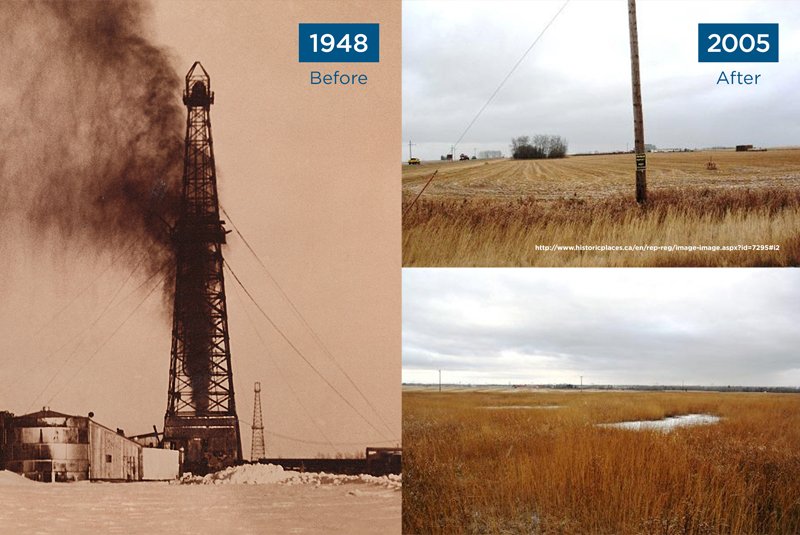This week 68 years ago, Alberta’s biggest blowout gasped its final breath
Alberta - November 07, 2016Almost seven decades ago, a drilling rig towering high over an empty field ignited more than just the ground it stood on.
No one expected a 150-foot blast of oil to explode out of the Atlantic No. 3 well site near Leduc. But before sunrise on March 8, 1948, the rogue well produced the largest oil spill in Alberta’s history, making front page news around the world and sparking significant change in the regulatory system.
And it all took place just 40 kilometres southwest of downtown Edmonton.
With little warning, a deafening sound rose from the well as it began to expel crude oil and natural gas, spraying fields almost five kilometres away. As the weather warmed and the months passed, great volumes of oil and gas continued to gush out of Atlantic No. 3—operated by Atlantic Oil Company—forming large craters in surrounding fields.
For six months, more than one million barrels of oil blew from the well and flooded nearby farms. Crews on site stuffed everything but the kitchen sink down the well in an attempt to plug it—bags of cement, cottonseed, saw dust, and even chicken feathers—with little success. It appeared Atlantic No. 3 was unstoppable.
Alberta’s most spectacular well fire

As thunderstorm season rolled in and with it the risk of electrical fires, the Petroleum and Natural Gas Conservation Board (PNGCB)—one of the AER’s early predecessors—took over the well and managed relief efforts. This was a first-time move for the 10-years-young regulator.
Worries became reality on September 6, when Atlantic No. 3’s derrick finally collapsed under the cratered ground and set the spill on fire. How the fire started is not known. According to Daniel Claypool, historian at the Leduc #1 Energy Discovery Centre museum, some speculate that pieces of metal shot out of the well and struck the rig, creating a spark.
Nevertheless, the resulting inferno reached more than 200 metres into the air; a nearby farm field was converted into a flaming lake under a mushroom cloud of black smoke. The incredible blaze continued to burn for nearly three days.
The severity of the disaster soon caught the eye of news media and many others around the world. More than anyone else, images of the towering inferno sent a clear and convincing message to global investors: Alberta was indeed an oil province.
“When video reels of the fire hit theatres everywhere, from New York to Paris, that’s when the international money started flooding in,” explains Claypool. Even today, Atlantic No. 3 is credited with bringing international attention to Alberta’s energy industry. It reportedly brought $40 million of free publicity into the province.
After months of trial and error, the hole was finally sealed on November 9. The PNGCB hired senior professionals to finish the job, supervised cleanup crews, and held the owner of the site, Atlantic Oil Company, accountable for the mess.
Why it happened
Claypool says that the major culprit behind the spill was the crew’s decision to drill the well “blind and dry.” Wells are typically drilled using a special kind of mud to counter the intensive pressure of natural gas beneath the surface. When this “drilling mud” is pumped down a well to control the pressure, it must “circulate” or return to the surface in order to maintain that control.
Atlantic No. 3’s crew began using drilling mud, but soon found that it was not circulating back up the well; instead, the mud was seeping into holes beneath the ground in what were assumed to be limestone formations. The crew knew this was bad news and they needed a backup plan.
In an effort to bring the mud to surface, they decided to pump a large amount of water down the well. Unfortunately, this attempt wasn’t calculated properly, and with nothing to counteract the extreme downhole pressures, the ground shook violently and the well ruptured.
Lessons learned
Atlantic No. 3 woke up the entire industry to safer practices in the oil patch. In particular, the blowout was a critical learning lesson for the PNGCB: it motivated the young energy watchdog to step up its inspection and enforcement action for Alberta’s budding oil and gas industry. Unprecedented regulations were put into place to help prevent future blowouts and to revise surface casing and safety requirements; standards were set to ensure companies would use extreme caution when working with high–pressure wells. What is now known as Alberta’s most spectacular blowout tested the young regulator’s authority in a major crisis.
One year after the disaster, the land was levelled and seeded. Three more years passed and grain was planted just south of the well site, where it continues to grow.
Today, the Atlantic No. 3 blowout still burns in the minds of those who witnessed it, and is a distant memory of Alberta’s history to those who didn’t.
Kara MacInnes, Writer


